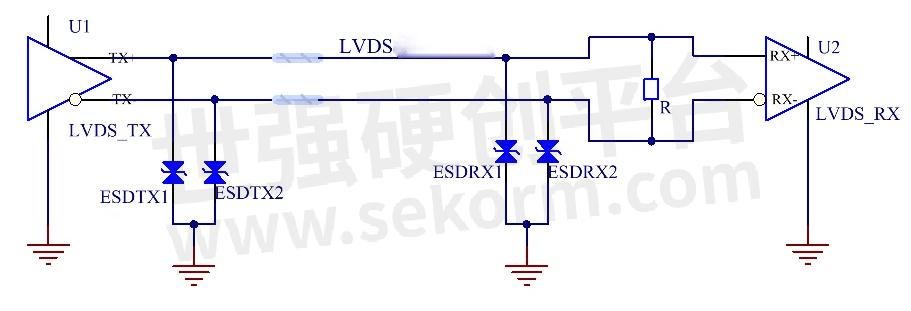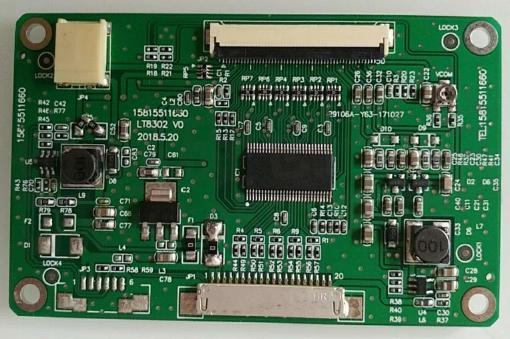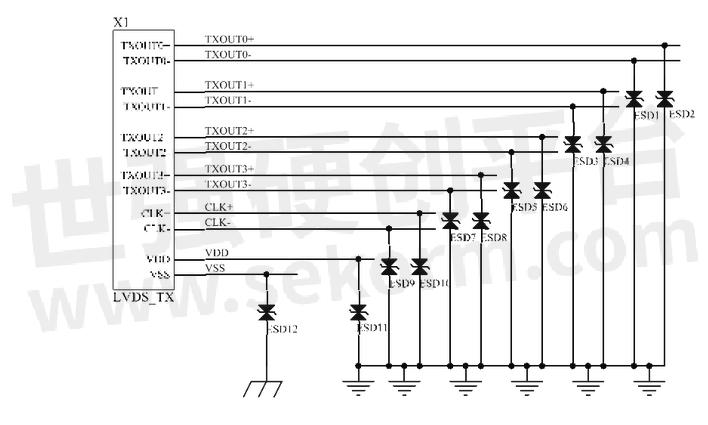Yint offers a LVDS (Low Voltage Differential Signaling) Interface Protection Scheme Based on Protection Device ESD0524P

LVDS (Low Voltage Differential Signaling) is a data transmission and interface technology proposed by NS (National Semiconductor) in the 1990s. The LVDS interface is also called the RS-644 bus interface. The physical interface uses a 1.2V bias to provide a 400mV swing signal, which solves the problems of high power consumption and large electromagnetic interference when transmitting high bit rate data in TTL level mode. LVDS has the characteristics of high transmission rate, low voltage, low power consumption, etc., and is gradually applied to the field of high-bit-rate data transmission, such as image and video data transmission. LVDS drivers and receivers are not dependent on a specific supply voltage, so it is easy to migrate to low-voltage powered systems.

Fig.1
Interface circuit type
Like the TTL interface, the LVDS interface circuit is also divided into two modes: single-channel RGB data transmission and odd/even pixel dual-channel RGB data transmission (also known as single-port LVDS, dual-port LVDS, 1-pixel LVDS, and 2-pixel LVDS). If the number of output bits (6bit, 8bit, 10bit) is considered, the types of LVDS interface circuits can be divided into the following types:
1. Single 6-bit LVDS bit interface
It is used to drive a 6-bit LCD panel and transmit RGB data in a single channel. Also known as 18-bit (6 bits each for R, G, and B) LVDS interface.
2. Dual 6-bit LVDS interface
It is used to drive a 6-bit LCD panel and transmit RGB data in a dual way of odd/even pixels. Also known as 36-bit (6 bits for odd/even RGB) LVDS interface.
3. Single 8-bit LVDS interface
It is used to drive 8-bit LCD panels and transmit RGB data in a single way. Also called the 24-bit LVDS interface.
4. Dual 8-bit LVDS interface
It is used to drive an 8-bit LCD panel and use odd/even pixel dual ways to transmit RGB data. Also called a 48-bit LVDS interface.
5. Single 10-bit LVDS interface
A single 10-bit LVDS interface is used to drive a 10-bit LCD panel and transmit 10-bit RGB data (RO~R9, GO-G9, B0~B9) in a single channel.
6. Dual 10-bit LVDS interface
Dual 10-bit LVDS interfaces are used to drive 10-bit LCD panels and use dual-channel transmission of 10-bit RGB data (odd channels: RO0~RO9, GO0~G09, B00~B09, even channels: REO~RE9, GEO~GE9, BEO~BE9).

Fig.2
Single line single cell protection scheme

Fig.3
At the LVDS sending end, each data line is added with a YINT electronic Co. Ltd. electrostatic protection device, which adopts SOD882 (DFN1006) or SOD923 ultra-small package, and the ultra-low capacitance is <1pF.
Multi-line comprehensive protection scheme

Fig.4
Yint Electronic Co. Ltd. makes full use of the ultra-small package DFN10 and ultra-low capacitance of 0.35pF of its own product multi-channel protection device ESD0524P, as well as the application experience of ESD0524P in high-speed transmission fields such as HDMI, USB3.0, G Ethernet, DVI, MDDI, and DDR. , design protection circuits for various applications of LVDS.
In addition to the above example circuits, Yint Electronics Co.Ltd. has corresponding circuit protection schemes for LVDS interface dual-channel 6-bit, dual-channel 8-bit, single-channel 10-bit, dual-channel 10-bit, etc., for your design reference.
- +1 Like
- Add to Favorites
Recommend
- YINT‘s ESD0524P ESD Protection Diode Design with Only 0.5mm Pitch to ESD Protection Circuits for HDMI
- Yint Electronics Recommends Electrostatic Protection Device ESD0524P for HDMI, VGA, DVI, Mini DP Video Data Interface
- Yint Offers Analog Video Interfaces Protection
- A 12V DC Lightning Protection Solution from Yint
- Yint Electronics Recommends Using a Varistor for Input Overvoltage Protection of Smart Meters
- Yint Electronics Provides Effective Circuit Protection for UWB Positioning Base Stations
- Yint Electronics MOV 14D561K, TVS SMBJ6.5CA P6SMBJ10CA for Power Line Carrier PLC Interface Circuit
- How To View The Importance Of Power Surges To The System?
This document is provided by Sekorm Platform for VIP exclusive service. The copyright is owned by Sekorm. Without authorization, any medias, websites or individual are not allowed to reprint. When authorizing the reprint, the link of www.sekorm.com must be indicated.






























































































































































































































































































































































































































































































































































































































































































































































































































































































